by Branan Freeman, Artist and Residential Education Manager at Esalen Institute
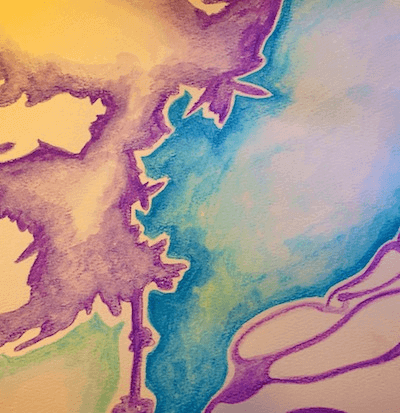
The change in seasons can bring about a sense of wonder, of noticing the details of nature’s colorful palette. There are many ways to enjoy our natural surroundings, including this gratitude practice incorporating creativity and our senses of sight, sound, smell and touch.
You may use any outdoor location, and all you need is a comfortable place to sit and a few materials to document aspects of your experience. I’ll delve into some suggestions, but feel free to tailor this to suit your own needs.
and/or:
Optional:
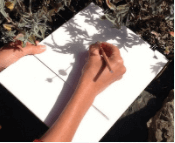
Step 1
Find a spot where the shadows of plants are cast over your paper. You can move your paper around a bit to find the composition that pleases you.
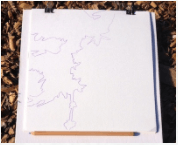
Step 2
Trace the shadow. You can simplify the shapes a bit or get as detailed as you like.
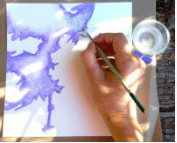
Step 3
Color in the shadow shapes. I used watercolor pencils, but any of the materials I suggested in the materials list will work nicely. After coloring in the shadow, I added a bit of water to my paintbrush to blend the watercolor pencil.
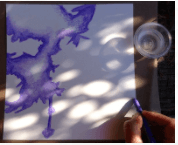
Step 4
As you create, you may become aware of shifting light and new shadows. Wonderful! Take time to capture this awareness and draw new shapes as you see them emerge.
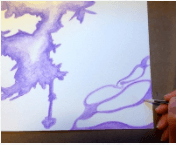
Step 5
Notice how different shadows cast unique shapes. In this image, I have very different styles, and that’s just fine with me. I’m enjoying the process!

Step 6
After defining shadow shapes, you can leave your artwork alone or keep going. I’ve decided to add some blue to the central part of the composition, again using my favorite watercolors pencils.
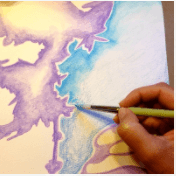
Step 7
Finish up your piece by adding finishing touches. Sometimes it’s hard to know when to stop...trust your instincts. You may want to take a moment away from your piece and look at it again with fresh eyes. Remember, we are giving ourselves permission to play, be aware of our senses and enjoy a gratitude practice for the wonders of nature!
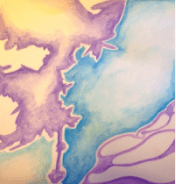
Step 8
Think of a title of your piece, or maybe add a journal entry on the back of the artwork, documenting the date, where you are and what you noticed. Consider diving into this project a few times this season or revisit at the seasons shift again and see how your images evolve. This could also be a fun project to do with some friends!

“Remembering to be as self compassionate as I can and praying to the divine that we're all a part of.”
–Aaron
“Prayer, reading, meditation, walking.”
–Karen
“Erratically — which is an ongoing stream of practice to find peace.”
–Charles
“Try on a daily basis to be kind to myself and to realize that making mistakes is a part of the human condition. Learning from our mistakes is a journey. But it starts with compassion and caring. First for oneself.”
–Steve
“Physically: aerobic exercise, volleyball, ice hockey, cycling, sailing. Emotionally: unfortunately I have to work to ‘not care’ about people or situations which may end painfully. Along the lines of ‘attachment is the source of suffering’, so best to avoid it or limit its scope. Sad though because it could also be the source of great joy. Is it worth the risk?“
–Rainer


“It's time for my heart to be nurtured on one level yet contained on another. To go easy on me and to allow my feelings to be validated, not judged harshly. On the other hand, to let the heart rule with equanimity and not lead the mind and body around like a master.”
–Suzanne
“I spend time thinking of everything I am grateful for, and I try to develop my ability to express compassion for myself and others without reservation. I take time to do the things I need to do to keep myself healthy and happy. This includes taking experiential workshops, fostering relationships, and participating within groups which have a similar interest to become a more compassionate and fulfilled being.“
–Peter


“Self-forgiveness for my own judgments. And oh yeah, coming to Esalen.”
–David B.
“Hmm, this is a tough one! I guess I take care of my heart through fostering relationships with people I feel connected to. Spending quality time with them (whether we're on the phone, through messages/letters, on Zoom, or in-person). Being there for them, listening to them, sharing what's going on with me, my struggles and my successes... like we do in the Esalen weekly Friends of Esalen Zoom sessions!”
–Lori

“I remind myself in many ways of the fact that " Love is all there is!" LOVE is the prize and this one precious life is the stage we get to learn our lessons. I get out into nature, hike, camp, river kayak, fly fish, garden, I create, I dance (not enough!), and I remain grateful for each day, each breath, each moment. Being in the moment, awake, and remembering the gift of life and my feeling of gratitude for all of creation.”
–Steven
“My physical heart by limiting stress and eating a heart-healthy diet. My emotional heart by staying in love with the world and by knowing that all disappointment and loss will pass.“
–David Z.
Today, September 29, is World Heart Day. Strike up a conversation with your own heart and as you feel comfortable, encourage others to do the same. As part of our own transformations and self-care, we sometimes ask for others to illuminate and enliven our hearts or speak our love language.
What if we could do this for ourselves too, even if just for today… or to start a heart practice, forever?
by Branan Freeman, Artist and Residential Education Manager at Esalen Institute

The change in seasons can bring about a sense of wonder, of noticing the details of nature’s colorful palette. There are many ways to enjoy our natural surroundings, including this gratitude practice incorporating creativity and our senses of sight, sound, smell and touch.
You may use any outdoor location, and all you need is a comfortable place to sit and a few materials to document aspects of your experience. I’ll delve into some suggestions, but feel free to tailor this to suit your own needs.
and/or:
Optional:

Step 1
Find a spot where the shadows of plants are cast over your paper. You can move your paper around a bit to find the composition that pleases you.

Step 2
Trace the shadow. You can simplify the shapes a bit or get as detailed as you like.

Step 3
Color in the shadow shapes. I used watercolor pencils, but any of the materials I suggested in the materials list will work nicely. After coloring in the shadow, I added a bit of water to my paintbrush to blend the watercolor pencil.

Step 4
As you create, you may become aware of shifting light and new shadows. Wonderful! Take time to capture this awareness and draw new shapes as you see them emerge.

Step 5
Notice how different shadows cast unique shapes. In this image, I have very different styles, and that’s just fine with me. I’m enjoying the process!

Step 6
After defining shadow shapes, you can leave your artwork alone or keep going. I’ve decided to add some blue to the central part of the composition, again using my favorite watercolors pencils.

Step 7
Finish up your piece by adding finishing touches. Sometimes it’s hard to know when to stop...trust your instincts. You may want to take a moment away from your piece and look at it again with fresh eyes. Remember, we are giving ourselves permission to play, be aware of our senses and enjoy a gratitude practice for the wonders of nature!

Step 8
Think of a title of your piece, or maybe add a journal entry on the back of the artwork, documenting the date, where you are and what you noticed. Consider diving into this project a few times this season or revisit at the seasons shift again and see how your images evolve. This could also be a fun project to do with some friends!

“Remembering to be as self compassionate as I can and praying to the divine that we're all a part of.”
–Aaron
“Prayer, reading, meditation, walking.”
–Karen
“Erratically — which is an ongoing stream of practice to find peace.”
–Charles
“Try on a daily basis to be kind to myself and to realize that making mistakes is a part of the human condition. Learning from our mistakes is a journey. But it starts with compassion and caring. First for oneself.”
–Steve
“Physically: aerobic exercise, volleyball, ice hockey, cycling, sailing. Emotionally: unfortunately I have to work to ‘not care’ about people or situations which may end painfully. Along the lines of ‘attachment is the source of suffering’, so best to avoid it or limit its scope. Sad though because it could also be the source of great joy. Is it worth the risk?“
–Rainer


“It's time for my heart to be nurtured on one level yet contained on another. To go easy on me and to allow my feelings to be validated, not judged harshly. On the other hand, to let the heart rule with equanimity and not lead the mind and body around like a master.”
–Suzanne
“I spend time thinking of everything I am grateful for, and I try to develop my ability to express compassion for myself and others without reservation. I take time to do the things I need to do to keep myself healthy and happy. This includes taking experiential workshops, fostering relationships, and participating within groups which have a similar interest to become a more compassionate and fulfilled being.“
–Peter


“Self-forgiveness for my own judgments. And oh yeah, coming to Esalen.”
–David B.
“Hmm, this is a tough one! I guess I take care of my heart through fostering relationships with people I feel connected to. Spending quality time with them (whether we're on the phone, through messages/letters, on Zoom, or in-person). Being there for them, listening to them, sharing what's going on with me, my struggles and my successes... like we do in the Esalen weekly Friends of Esalen Zoom sessions!”
–Lori

“I remind myself in many ways of the fact that " Love is all there is!" LOVE is the prize and this one precious life is the stage we get to learn our lessons. I get out into nature, hike, camp, river kayak, fly fish, garden, I create, I dance (not enough!), and I remain grateful for each day, each breath, each moment. Being in the moment, awake, and remembering the gift of life and my feeling of gratitude for all of creation.”
–Steven
“My physical heart by limiting stress and eating a heart-healthy diet. My emotional heart by staying in love with the world and by knowing that all disappointment and loss will pass.“
–David Z.
Today, September 29, is World Heart Day. Strike up a conversation with your own heart and as you feel comfortable, encourage others to do the same. As part of our own transformations and self-care, we sometimes ask for others to illuminate and enliven our hearts or speak our love language.
What if we could do this for ourselves too, even if just for today… or to start a heart practice, forever?
by Branan Freeman, Artist and Residential Education Manager at Esalen Institute

The change in seasons can bring about a sense of wonder, of noticing the details of nature’s colorful palette. There are many ways to enjoy our natural surroundings, including this gratitude practice incorporating creativity and our senses of sight, sound, smell and touch.
You may use any outdoor location, and all you need is a comfortable place to sit and a few materials to document aspects of your experience. I’ll delve into some suggestions, but feel free to tailor this to suit your own needs.
and/or:
Optional:

Step 1
Find a spot where the shadows of plants are cast over your paper. You can move your paper around a bit to find the composition that pleases you.

Step 2
Trace the shadow. You can simplify the shapes a bit or get as detailed as you like.

Step 3
Color in the shadow shapes. I used watercolor pencils, but any of the materials I suggested in the materials list will work nicely. After coloring in the shadow, I added a bit of water to my paintbrush to blend the watercolor pencil.

Step 4
As you create, you may become aware of shifting light and new shadows. Wonderful! Take time to capture this awareness and draw new shapes as you see them emerge.

Step 5
Notice how different shadows cast unique shapes. In this image, I have very different styles, and that’s just fine with me. I’m enjoying the process!

Step 6
After defining shadow shapes, you can leave your artwork alone or keep going. I’ve decided to add some blue to the central part of the composition, again using my favorite watercolors pencils.

Step 7
Finish up your piece by adding finishing touches. Sometimes it’s hard to know when to stop...trust your instincts. You may want to take a moment away from your piece and look at it again with fresh eyes. Remember, we are giving ourselves permission to play, be aware of our senses and enjoy a gratitude practice for the wonders of nature!

Step 8
Think of a title of your piece, or maybe add a journal entry on the back of the artwork, documenting the date, where you are and what you noticed. Consider diving into this project a few times this season or revisit at the seasons shift again and see how your images evolve. This could also be a fun project to do with some friends!

“Remembering to be as self compassionate as I can and praying to the divine that we're all a part of.”
–Aaron
“Prayer, reading, meditation, walking.”
–Karen
“Erratically — which is an ongoing stream of practice to find peace.”
–Charles
“Try on a daily basis to be kind to myself and to realize that making mistakes is a part of the human condition. Learning from our mistakes is a journey. But it starts with compassion and caring. First for oneself.”
–Steve
“Physically: aerobic exercise, volleyball, ice hockey, cycling, sailing. Emotionally: unfortunately I have to work to ‘not care’ about people or situations which may end painfully. Along the lines of ‘attachment is the source of suffering’, so best to avoid it or limit its scope. Sad though because it could also be the source of great joy. Is it worth the risk?“
–Rainer


“It's time for my heart to be nurtured on one level yet contained on another. To go easy on me and to allow my feelings to be validated, not judged harshly. On the other hand, to let the heart rule with equanimity and not lead the mind and body around like a master.”
–Suzanne
“I spend time thinking of everything I am grateful for, and I try to develop my ability to express compassion for myself and others without reservation. I take time to do the things I need to do to keep myself healthy and happy. This includes taking experiential workshops, fostering relationships, and participating within groups which have a similar interest to become a more compassionate and fulfilled being.“
–Peter


“Self-forgiveness for my own judgments. And oh yeah, coming to Esalen.”
–David B.
“Hmm, this is a tough one! I guess I take care of my heart through fostering relationships with people I feel connected to. Spending quality time with them (whether we're on the phone, through messages/letters, on Zoom, or in-person). Being there for them, listening to them, sharing what's going on with me, my struggles and my successes... like we do in the Esalen weekly Friends of Esalen Zoom sessions!”
–Lori

“I remind myself in many ways of the fact that " Love is all there is!" LOVE is the prize and this one precious life is the stage we get to learn our lessons. I get out into nature, hike, camp, river kayak, fly fish, garden, I create, I dance (not enough!), and I remain grateful for each day, each breath, each moment. Being in the moment, awake, and remembering the gift of life and my feeling of gratitude for all of creation.”
–Steven
“My physical heart by limiting stress and eating a heart-healthy diet. My emotional heart by staying in love with the world and by knowing that all disappointment and loss will pass.“
–David Z.
Today, September 29, is World Heart Day. Strike up a conversation with your own heart and as you feel comfortable, encourage others to do the same. As part of our own transformations and self-care, we sometimes ask for others to illuminate and enliven our hearts or speak our love language.
What if we could do this for ourselves too, even if just for today… or to start a heart practice, forever?